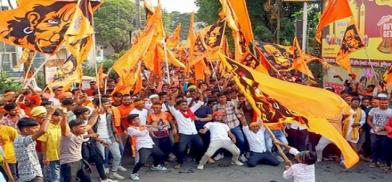When festivals become tools of hatred not harmony
What needs to be understood for prevention is that most of the time these processions, which are well armed, deliberately decide to pass through Muslim majority areas, with loud music and provocative and abusive slogans. It has become a pattern that someone will climb over the mosque and replace the green flag with saffron flag and the crowds down below dance and give a big applause.

As far Hindu festivals and their celebrations are concerned, from centuries they have assumed a sort of culturally integrating factor. The major example of this is that most Hindu festivals were celebrated not only in Mughal courts but also were jointly celebrated with Muslims. I do recall the Ram Navami procession in my childhood was such a time to be joyous and go round the city in a procession in festive mood.
This book is based on the in-depth inquiry into the violence instigated by the religious processions as a part of celebrations of festivals, Ram Navami in particular in years 2022-2023. It seriously analyses the incidents following the inquiry by the teams in which they participated. The violence covered in the book relates to Howrah and Hoogly (2023), Sambahji Nagar (2023),Vadodara (2023), Biharsharif and Sasaram 2023, Khargone (2022), Himmat Nagar and Khambat (2022) and Lohardagga (2022).
This book is relevant as its observations can be of great help in preventing the violence by ensuring that the pattern which is coming into being should be prevented for maintaining peace among communities. Irfan Engineer in the introduction points out, “Even a small Group of Hindu nationalists masquerading as ‘religious procession’ could insist on passing through minority inhabited area and provoke some youth using political and abusive slogans and playing violent songs and music, hoping that a reaction, a stone would be thrown at them. The state would do the rest by arresting a large number of members of a minority and demolishing their homes and properties within days without any judicial procedure.” (Page 24)
What needs to be understood for prevention is that most of the time these processions, which are well armed; deliberately decide to pass through Muslim majority areas, with loud music and provocative and abusive slogans. It has become a pattern that someone will climb over the mosque and replace the green flag with saffron flag and the crowds down below dance and give a big applause. Such a phenomenon has seen a boost particularly after the 2014 with the BJP government coming to power at center. The Khargone incident is very revealing in this regard. A minster of the MP government said stones were thrown on the procession, which have come from Muslim households; so these households are to be turned into stones.
In addition to Ram Navami other local religious Yatras (processions), Ganga Aarti, (Prayer for river Ganges),Satsangs (religious meeting) , and other religious programs are being started with similar goals. The example of Kanwar Yatras (holy pilgrimage to collect Ganges water) is another example where the participants become aggressive. To add insult to the injury, the UP and Uttarakhand governments issued orders that all stalls and eateries on the path of the Yatra should write the name of the owner on the boards so that the Kanwariyas (the participants in the pilgrimage) can avoid those owned by Muslims. Fortunately, the Supreme Court has put a restraint on this order.
State needs to play its role
Such violence is intensifying the prevailing fears amongst Muslim community. It is deepening the polarization and is increasing the atmosphere of fear. The festivals, times to enjoy and celebrate, are being used to instill fear and violence. The book is very relevant as it calls upon the state to take measures by anticipating the moves of communal organizations planning such processions. Carrying arms and use of loud music with songs abusive to minority communities have to be stopped by administration. This is very much within the law, as we have laws to punish those spreading hatred, including through DJs. The State has a crucial role to play in preventing this alarming rise of denigrating religious festivals.
A proper inquiry and suitable punishment to culprits is a must in addition to compensating the victims. And finally we have to start community programs for unity and amity, through cultural programs and popularization of films and videos promoting harmony. In the foreword, Tushar Gandhi, the great grandson of Mahatma Gandhi, emphasizes that we need to reach the messages of Mahatma Gandhi time and over again to bring sanity to our society. This is so pertinent and crucial in the present times.
(The writer, a former IIT Bombay professor, is Chairman, Centre for Study of Society and Secularism, Mumbai. Views expressed are the author's own.)










Post a Comment